Disclaimer: I do not work for any edtech companies and I have no desire to work for any edtech companies. I have no skin in this game. I make absolutely no money off any apps and plan on keeping it that way. This disclaimer means I have nothing to disclaim and you are getting my straight-up opinion here.
People often ask me what apps I can recommend for multiplication and division fact fluency. This question usually puts me in a tough position because, while eventual automaticity matters, I care about building conceptual understanding of these operations. My buddy Graham Fletcher recently described one path the progression of multiplication can take in this outstanding video. As Graham points, out, let’s not rush past all that great work!
And yet the requests come. This week, I fielded one from a teacher I needed to answer, so I threw the question out to twitter to see what’s new on the market. I’ve been looking around since, and the big money math fact app world is enough to send me into despair. It’s almost all awful. As I looked at them, I noticed I use three baseline criteria, and I’m unwilling to compromise on any of them:
- No time pressure. In some apps, there is a giant timer counting down. Or you have to answer before the sun sets. Or the context is such that the whole experience feels like an anxiety nightmare.
These screen shots came from the Arcademics game “Meteor Multiplication.” They’re basically embedding flash cards in the great Atari game of my youth, “Asteroids.” Except now, blasting asteroids isn’t fun. Now, if I can’t think of my facts fast enough while the meteors close in on me, I feel like I’ll be crushed to death. I know my facts. I found it hard to think when facing impending doom. This isn’t surprising. Studies like the one from Ashcraft and Moore have shown that:
“Overall, math anxiety causes an “affective drop,” a decline in performance when math is performed under timed, high-stakes conditions, both in laboratory tests as well as in educational settings. This means that math achievement and proficiency scores for math-anxious individuals are underestimates of true ability. The primary cognitive impact of math anxiety is on working memory, particularly problematic given the important role working memory plays in math performance.”
I don’t have math anxiety, but many of our students and teachers do, and timed drill is a leading cause. My 1st-grade daughter’s classmates told me they have stomachaches from the “Speed Round” in Addimals. Under no circumstances will I recommend any apps that involve time pressure or speed rounds. This criterion strikes the vast majority of apps because the premise of so many of them is that speed races are “fun.”
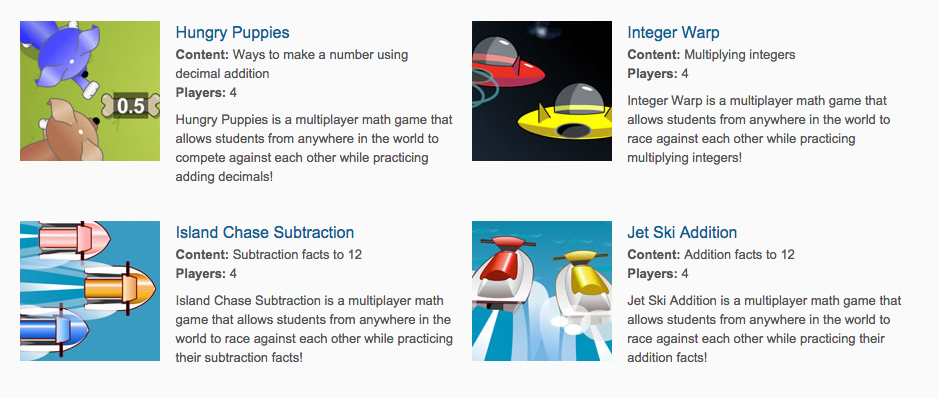
Source: http://www.arcademics.com/games/ - Conceptual Basis for the Operations. I don’t want to see naked number drills, especially not for 3rd graders. Flashcards embedded in silly or glitzy contexts are still flashcards. I want to see mathematical models like arrays, groups, hundreds charts, and number lines. Most of the apps put their money into developing exciting or humorous graphics to lure in customers, but what kind of mathematical sense does this make?
This screenshot is from SumDog’s Junk Pile, where the answers to math problems inexplicably turn into trash piled up in a junkyard. In this example, my correct answer to 80 – 10 turned into garbage. I mean, I’m trying not to be too sensitive here, but what kind of message does it send when we turn math into garbage? Literally! The first question I answered turned into a toilet bowl.
- Mistakes Must Be Handled Productively. The first thing I do when I trial a game is I make mistakes on purpose to see what will happen. The overwhelming majority of apps give some form of a Family-Feud-style giant red X. Sometimes with flames, molten lava, or puffs of smoke, because I guess the X is too subtle?
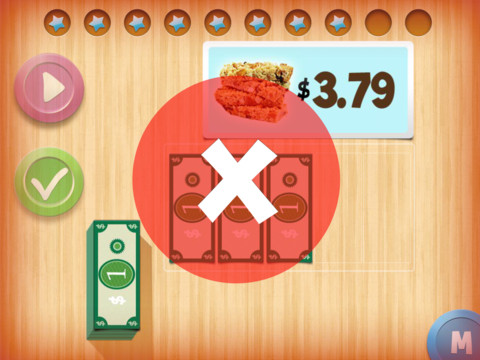
Source: http://www.specialeducationadvisor.com/wp-content/uploads/2012/05/next-dollar-up-3.jpg I’d estimate that, 9 times out of 10, most apps just move to the next problem after a mistake. The kids don’t get to figure out where they went wrong, don’t get to learn from the mistake, and don’t get to try again. Talk about missed opportunities. And then there’s the way mistakes affect scores and the endless parade of stickers, stars, and tokens in these games.
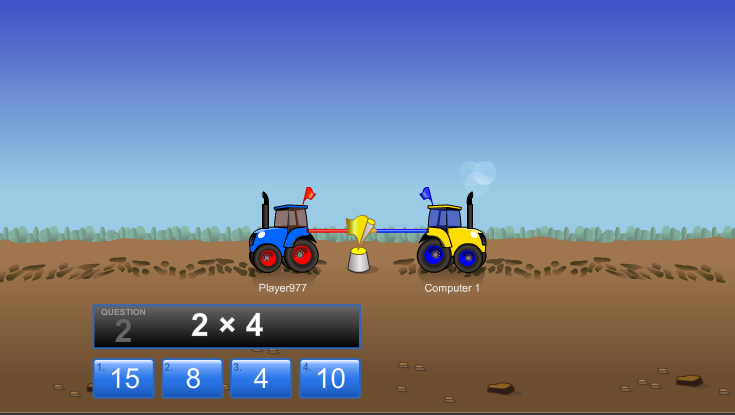
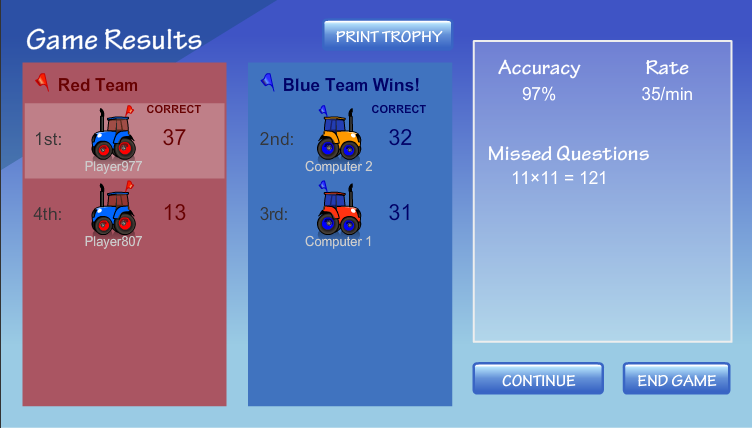
Source: http://www.arcademics.com/games/tractor-multiplication/tractor-multiplication.html In this game, we played tug-of-war in tractors, because I guess that’s a thing. Anyway, it was a race. In the second round, we did some tandem tractoring where I was partnered with a stranger on the internet and we raced two computers. I was Player977, and I answered 35 questions/minute. That’s a much faster rate than we can ever expect students to recall facts, even with automaticity. I made one mistake on purpose and guess what? We lost. I can’t tell if I lost because of the one mistake, or I lost because my internet-anonymous partner, Player807, needed a little more time to answer. Am I supposed to think of Player807 as deadweight? I mean, come on. However I slice it, I lost through some algorithm that only counts speed and correct answers and discounts mistakes as bad. Little surprise that most of these app web pages have correct answer counters, like McDonald’s does for burgers.

So what apps can I recommend? The list is painfully short. One program rises right to the top. Dreambox is my preferred app, without a doubt, by a mile, far and away from the others. Students have plenty of time to think. Cathy Fosnot’s landscapes are built right into the structure of the app, so students are often working on a variety of interrelated ideas and models. For example, Daphne is in 1st grade, and she’s working with rekenreks, number lines, and tens frames.
The modeling is just off the hook. I took these screenshots while Maya (3rd grade) was working in a context for place value. She needed to think of 4 different ways to pack 703 objects among cases of 100, boxes of 10, and loose 1s.
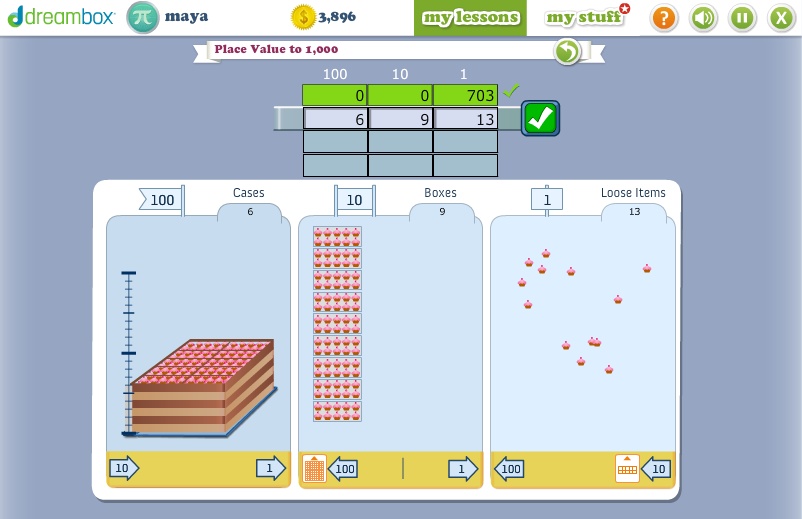
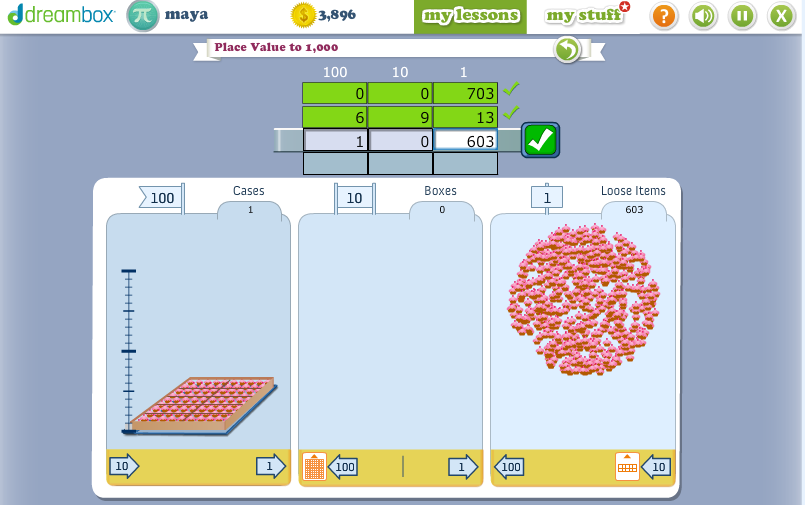
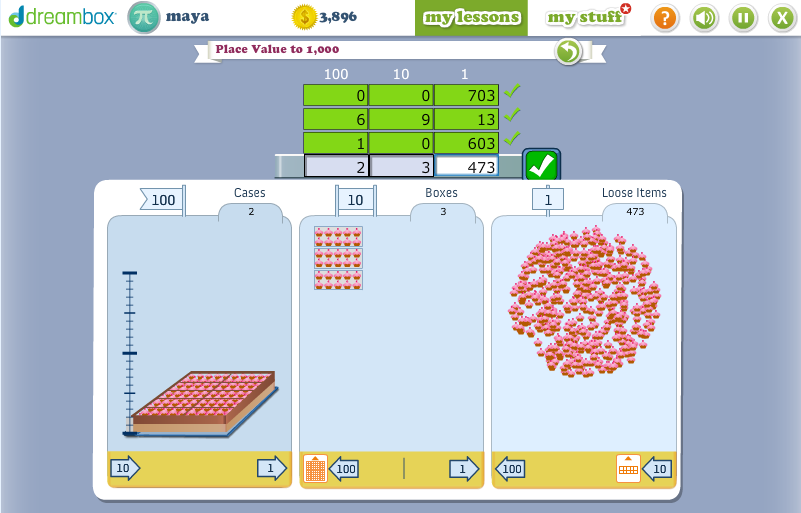
Given the poor conceptual underpinning of my kids’ curriculum, I sprang for dreambox at home, so I get to peek over Maya and Daphne’s shoulders now and then as they play. When they make a mistake, the response is, “Oops. Something doesn’t seem quite right.” The kids are expected to try again. If they’re stumped, the app supplies really good support, layered in like a teacher would.
This is straight talk. My kids love dreambox and ask to play regularly. I’m down with it because, on top of it nailing all three of my criteria, the story contexts are fun – pirate ships, dinosaur fossil excavations, amusement parks – and the messaging about math is aces from both equity and growth mindset vantage points.
What else is out there? I’ve heard good things about Wuzzit Trouble from Keith Devlin. I haven’t tried it myself, though. I plan on giving it a go.
h/ts to John Golden and Paula Krieg for pointing me toward Bunny Times this week: It’s actually free. It isn’t as glitzy as the other apps and doesn’t produce teacher reports or have a dashboard. It’s also focused singularly on multiplication using arrays. But, my friends, the math is right.
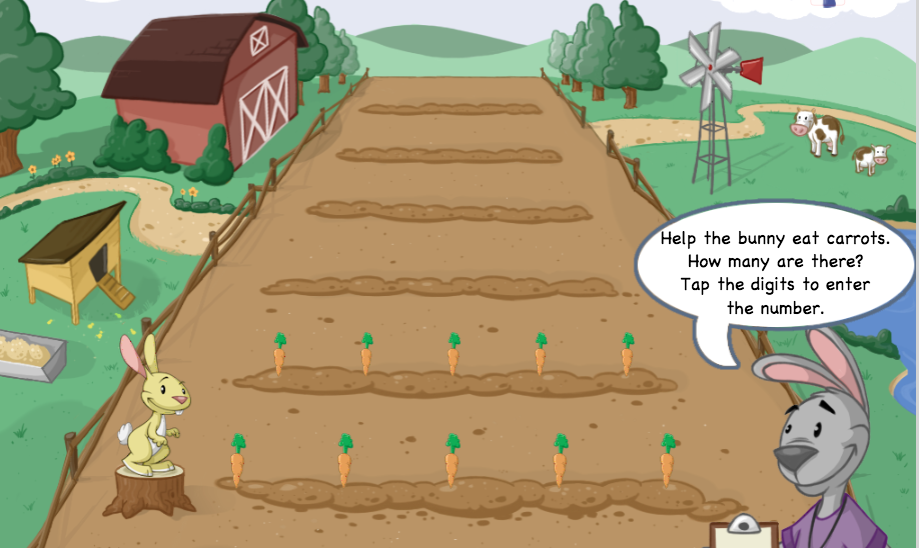
They build in some nice decomposition work as the problems get bigger, so kids start to build foundational understanding of the distributive property.
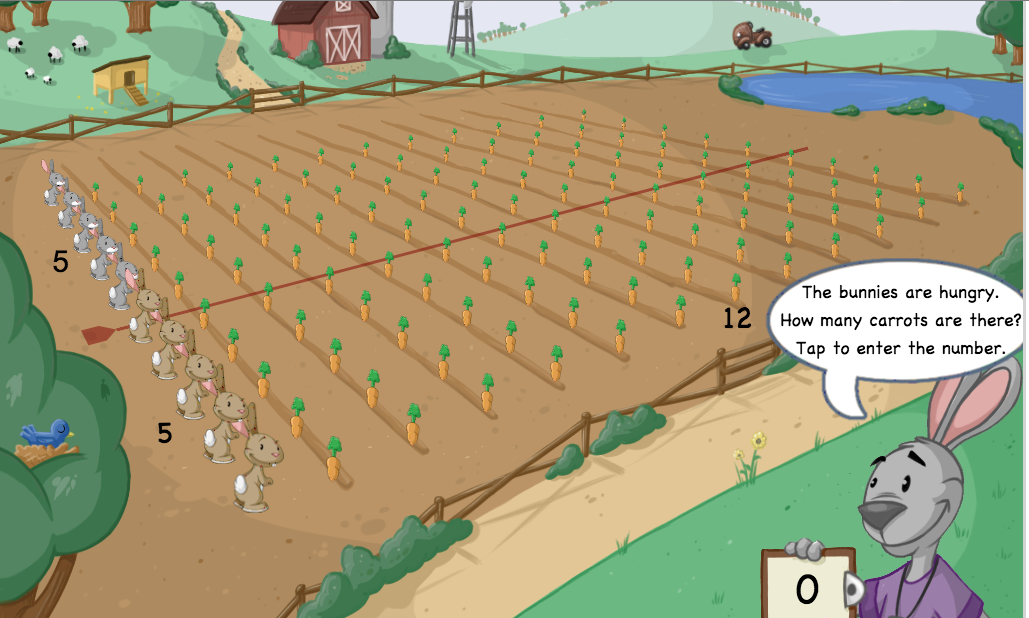
Over time, a fog rolls in, which discourages counting by ones.
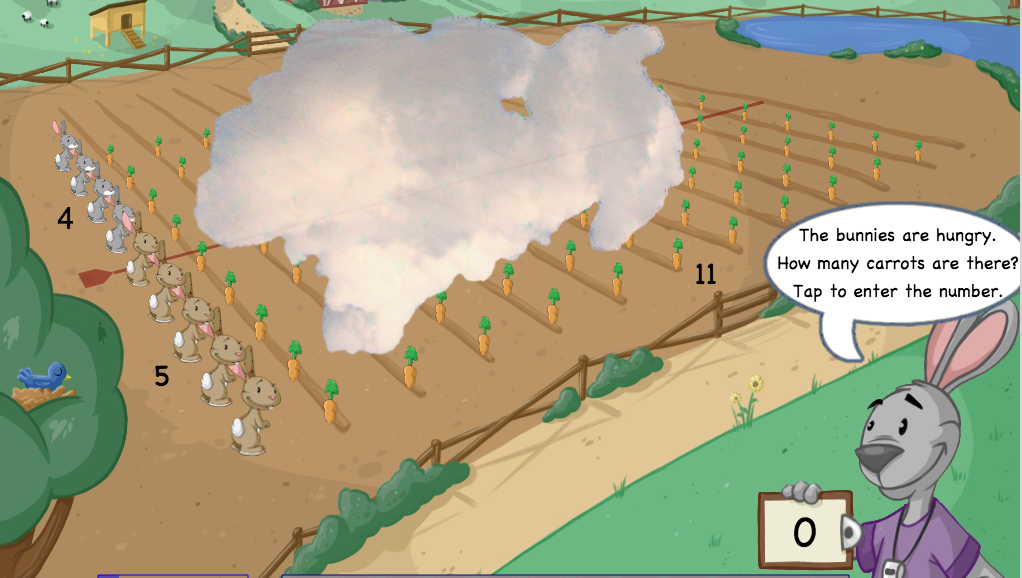
And check this out. Look what happens when you make a mistake.
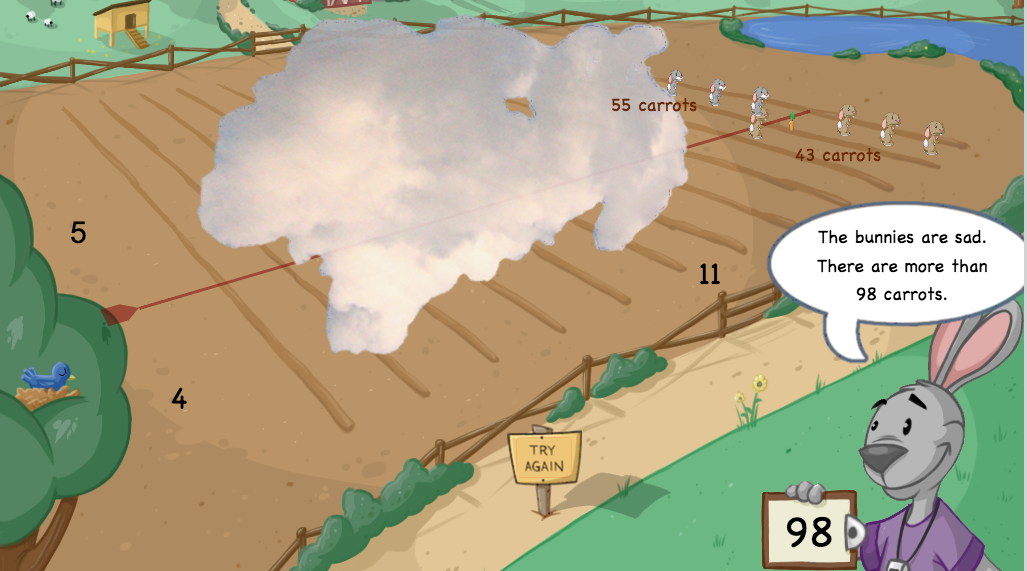
You see that feedback? See that carrot there? And do you see that lovely sign, right in the foreground? The one that says, “TRY AGAIN?” So we did.
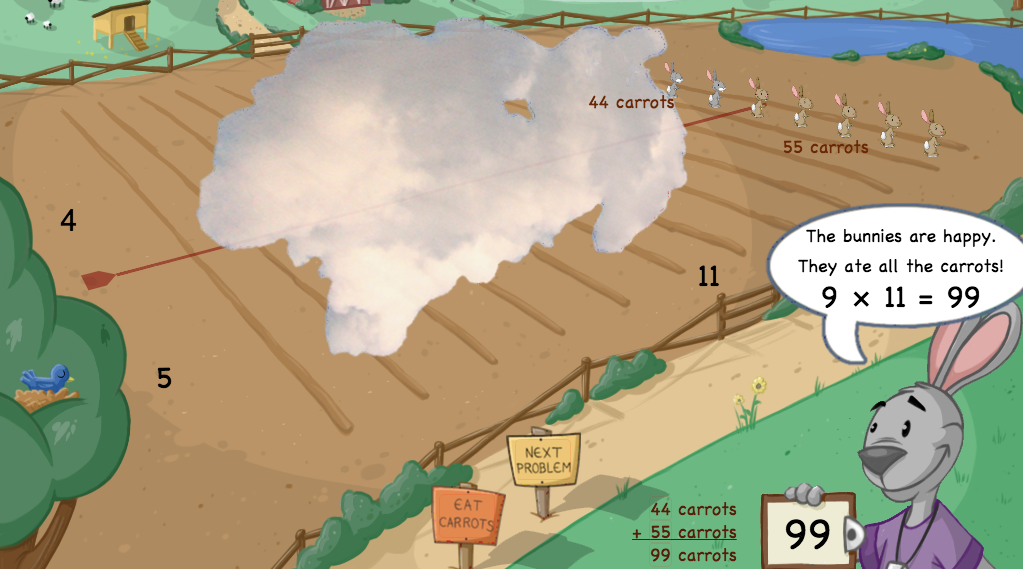
I wondered what Maya would think of this app. She adored it, and I watched her do some really good thinking. For example, she’s still a big fan of doubling. At the beginning of her bunny time, she’d think about a problem like 8 x 12 as 2 x 12 = 24, 24 x 2 = 48, 48 x 2 = 96. After some time with the bunnies, I saw her solve 8 x 12 with (8 x 10) + (8 x 2). That’s a nice development. She started thinking strategically about breaking the dimensions into smaller numbers, using more 5s and 10s and place value-based thinking.
So, I was saved from my despair by the lovely design at dreambox and the solid math of the bunnies.
My message to most app makers? Try again.
Clarification, Jan 5 2016.
I think I need to clear something up. Dreambox and the Bunny Times aren’t comparable. Dreambox is a full program. Soup to nuts, as they say, A huge K-8 progression, thoughtfully organized and designed, that develops both understanding AND fluency, together. That’s why I like it so much. And, I’m sorry to say, that’s why its pricepoint is much higher.
The Bunny Times has nothing like the scope or scale of dreambox. It’s not trying to be more than it is. It’s an app tightly focused on one part of developing multiplication. But when they decided how to structure it, I think they did a nice job thinking it through.
And they met my criteria of no time pressure, a conceptual basis, and handling mistakes productively.
I personally think that’s not a high bar. I mean, those three criteria are my bare minimum. That’s why it’s stunning that so few apps clear it.
People have been tossing apps my way all day both on twitter and in the comments. I’m happy to take a look. But I’m telling you right now, if it has time pressure, no emphasis on understanding, or poor handling of mistakes, it gets a fail from me.
Clarification #2 Jan 7 2016
Looking through comments and twitter conversation about this blog, it seems there are two things I didn’t make nearly clear enough.
- This list is not exhaustive. I certainly didn’t try everything out there. I shared dreamBox and Bunny Times as two examples at two price points and two scopes that meet the criteria I outlined. And I shared that I’ve purchased dreamBox at home because I think it’s great.
- Lots of people have been asking about other factors and attributes about games, apps, subscriptions, programs, etc. This is a great question and the main thing I want to clarify. There are lots of other characteristics I look for when evaluating games and apps. Here’s a partial list, the best brain dump I could do before caffeine this morning:
Is the game engaging? Do kids like it? Are they motivated to use it? Does it encourage students to interact with each other? Does it help build mathematical intuition and sense-making through things like prediction, estimation, revision, reflection? Do students get multiple iterations to solve until they decide they’re satisfied and pleased? Does it reduce barriers to entry? Does it break down or contribute to stereotypes about who can and can’t do math (students of color, multilingual students, students with disabilities, gender)? Is the mathematics it addresses important? Does it contribute to societal myths about what mathematics is, or unseat them? Does it adapt to students’ performance? Does it yield useful formative assessment for teachers (not just “data”)? Do the problems have any openness (beginning, middle, end) or is it all answer-getting? Do students get to write? Are there options for student creativity and initiative? How are the graphics? Is there mathematical beauty and delight? Do the kids ever get to choose among representations and models or create representations and models themselves, or is everything provided? Do the kids decide their strategy or do they execute what the program chooses? Does it portray mathematics as inherently interesting, or something that needs to be dressed up in gimmicks and rewards?
If you’re wondering what program could possibly do all that well, I’ll send you to teacher.desmos.com. Have a look around. Enjoy.
But here’s the deal. In this particular blog, I wasn’t trying to list all the things I consider. I was trying to give my 3 non-negotiables. As I said above, I won’t compromise on any of them. I don’t actually care how great the graphics are, how good the teacher reports are, or how many people tell me “but kids like it!” if the program has time pressure, no conceptual basis, and handles mistakes negatively.
That’s what I meant by baseline criteria. If an app meets those three criteria, then I’ll look at the rest. But when I first look at an app, these are my three questions:
- Is there time pressure?
- Is it conceptual?
- How does it handle mistakes?
Update July 11 2016
Thanks to Julie Wright and Dan Meyer for recommending Sumaze! Super strong. Thumbs up. And free!




